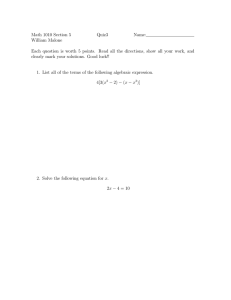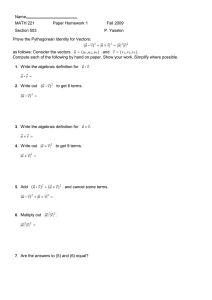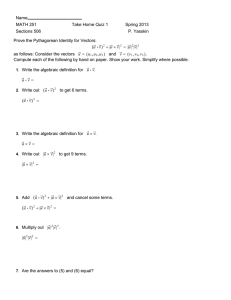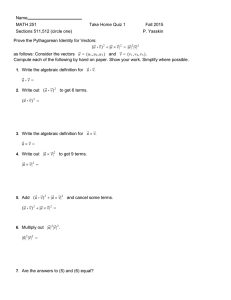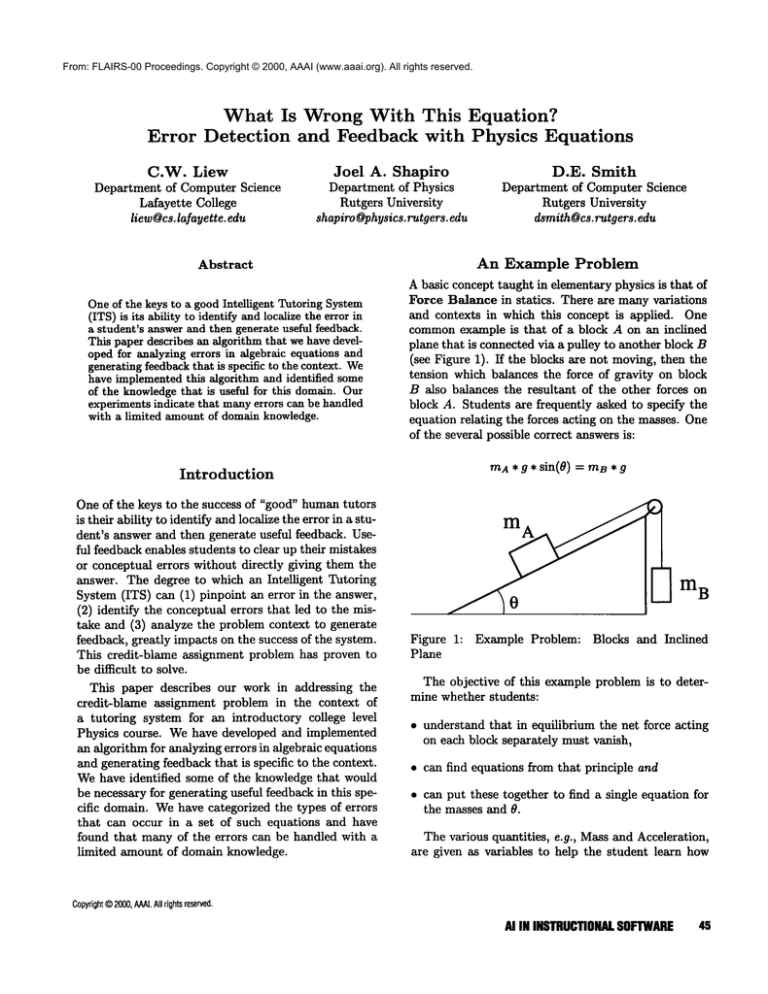
From: FLAIRS-00 Proceedings. Copyright © 2000, AAAI (www.aaai.org). All rights reserved.
What Is Wrong With This Equation?
Error Detection
and Feedback with Physics Equations
C.W. Liew
Department of Computer Science
Lafayette College
liew@cs,lafayette, edu
JoelA. Shapiro
Department
of Physics
Rutgers
University
shapiro @physics.rutgers, edu
Abstract
Oneof the keys to a goodIntelligent Tutoring System
(ITS) is its ability to identify and localize the error
a student’s answerand then generate useful feedback.
This paper describes an algorithm that we have developed for analyzing errors in algebraic equations and
generating feedbackthat is specific to the context. We
have implementedthis algorithm and identified some
of the knowledgethat is useful for this domain. Our
experiments indicate that manyerrors can be handled
with a limited amountof domain knowledge.
Introduction
One of the keys to the success of "good" humantutors
is their ability to identify and localize the error in a student’s answer and then generate useful feedback. Useful feedback enables students to clear up their mistakes
or conceptual errors without directly giving them the
answer. The degree to which an Intelligent Tutoring
System (ITS) can (1) pinpoint an error in the answer,
(2) identify the conceptual errors that led to the mistake and (3) analyze the problem context to generate
feedback, greatly impacts on the success of the system.
This credit-blame assignment problem has proven to
be difficult to solve.
This paper describes our work in addressing the
credit-blame assignment problem in the context of
a tutoring system for an introductory college level
Physics course. Wehave developed and implemented
an algorithm for analyzing errors in algebraic equations
and generating feedback that is specific to the context.
Wehave identified some of the knowledge that would
be necessary for generating useful feedback in this specific domain. Wehave categorized the types of errors
that can occur in a set of such equations and have
found that many of the errors can be handled with a
limited amount of domain knowledge.
D.E. Smith
Department of Computer Science
Rutgers University
dsmith @cs.rutgers, edu
An Example Problem
A basic concept taught in elementary physics is that of
Force Balance in statics. There are many variations
and contexts in which this concept is applied. One
commonexample is that of a block A on an inclined
plane that is connected via a pulley to another block B
(see Figure 1). If the blocks are not moving, then the
tension which balances the force of gravity on block
B also balances the resultant of the other forces on
block A. Students are frequently asked to specify the
equation relating the forces acting on the masses. One
of the several possible correct answers is:
mA * g * sin(8)= mB *
m
B
Figure 1: Example Problem:
Plane
Blocks and Inclined
The objective of this example problem is to determine whether students:
¯ understand that in equilibrium the net force acting
on each block separately must vanish,
¯ can find equations from that principle and
¯ can put these together to find a single equation for
the masses and 8.
The various quantities, e.g., Mass and Acceleration,
are given as variables to help the student learn how
Copyright
©2000,
AAAL
Allrights
reserved.
AI IN INSTRUCTIONAL
SOFTWARE4S
to reason abstractly, i.e., without relying on numeric
quantities and calculators.
Someexample answers are listed below:
1. mA* g * sin(0) - mB* g =
2. g * (raA * sin(0) - roB) -3.
mB*g+mA*g*sin(O)=O
4.
mB*g--mA*g*cos(0)=O
5.
mA*g-~O
The answers above are all dimensionally consistent,
i.e., all the terms are Forces, but only the first two axe
correct. The rest are incorrect in different ways, and
sometimes in a combination of ways. The issues we
are interested in are (1) howto detect and localize the
errors and (2) how to generate appropriate feedback
to the student. In an earlier paper (Liew, Shapiro,
Smith 1999), we described how we have approached
the problem of making sense of the equation in terms
of physical quantities, i.e., how do we recognize that
mA * g is a Force?
Some Current
Approaches
and Techniques
There are several techniques that have been used for
the identification of conceptual errors and generation
of appropriate feedback. These techniques include:
¯ allowing the user to only select from a list of preenumerated responses: Each response is associated
with a known conceptual error. Multiple choice
mechanisms are an example of this technique.
¯ enumerating the possible answers and comparing the
submitted answer against the enumeration: Each
memberof the pre-enumerated list would have to
be matched against a corresponding message or a
template for a message. This can be painstaking
and require mucheffort on the part of the problem
designer.
¯ simulation of the submitted answer: The tutoring
system incorporates either implicitly or explicitly a
model of the concepts being tested. The student’s
answer is simulated to determine what (incorrect)
outcomes could be generated. The CIRCSIM(Hume
et al. 1993; 1995) system uses a knowledge base
of causal models for tutoring medical students on
cardiovascular physiology.
¯ The ANDESsystem (VanLehn 1996) compares each
term in an algebraic equation against terms in the
solution. Our approach is similar but takes a further step in generating feedback that is specific to
Physics. The ANDES
system’s feedback is more general and refers more to algebraic errors.
46
FLAIRS-2000
The Credit-Blame
Assignment
Problem
The difficulty in analyzing student answers affects our
ability to provide helpful feedback on incorrect answers beyond the terse and unhelpful "Your answer
is incorrect". This difficulty relates to some of the
earliest work in building intelligent systems, that of
credit-blame assignment. Credit-blame assignment in
the context of an intelligent tutoring system consists
of the following steps:
¯ determine that the submitted answer is incorrect.
¯ localize the error to a componentof the answer.
¯ identify the likely conceptual error or mistake that
led to the mistake.
¯ generate feedback based on the context of the problem, i.e., what is the nature of the correct answer
versus the submitted answer? What information can
be provided that will guide the student without directly giving them the answer.
We have developed an algorithm for performing credit-blame assignment for algebraic answers in
Physics. Our algorithm is strongly biased towards the
domain of introductory Physics because it uses strong
domain knowledge to reason about the answers and
perform credit-blame assignment. The algorithm has
been implemented in the PHYSICS-TUTORsystem,
an ITS that is being developed for introductory Physics
courses.
Error Detection
Howthen do we perform credit-blame assignment for
algebraic equations in an introductory Physics course?
Westart by restricting the kinds of answers that the
student can provide.
¯ All variables required to solve the problem are explicitly mentioned in the problem statement or are
well-knownstandard quantities (e.g., g is the standard gravitational constant at Earth’s surface). The
instructor provides information about the variables
that cannot be deduced by the system. This information includes the dimensions of the variable
and where possible the Physics concept (e.g., Force,
Mass) represented by the variable.
¯ A unique identification of objects is required to localize and point out errors to the student. The system has heuristics about the features that can be
used to uniquely identify the objects in the problem.
Currently, the heuristics use properties of objects to
identify the objects. The properties of objects are
sometimes unique, e.g., mass rnl for an object, but
sometimes are not, e.g., objects A and B may both
have mass ml but may have unique velocities vo, vl.
Given the above restrictions
and a correct answer
(also an algebraic expression) supplied by the instructor, the PHYSICS-TUTOR
system uses the following
algorithm to analyze the student’s submitted expression:
1. Transform the submitted expression into a canonical
form. The canonical form is a sum of products = O.
of the problem that employs a freebody diagram of
one of the blocks. Hopefully, such suggestions will
focus attention on the critical Physics concepts and
help the student solve the current problem.
Generating
Feedback
Once the errors in a student’s expression close to the
right answer have been localized and identified, the
next step is to generate useful feedback. The feedback
is based in part on:
¯ the particular error,
2. Mapall variables in the expression to dimensions
and determine the dimensions of all the terms in the
expression tree. If the expression is not dimensionally consistent or if the expression contains an unknownvariable, then generate an appropriate error
message to the user. If the expression contains an
unknownvariable, the user has the option of specifying the dimensions of the variable, as well as modifying the submitted answer.
3. Mapterms in the expression to terms in the answer.
Each term in the expression is matched against every term in the answer using a heuristic based on the
symbols that occur in each term. There is a minimumlevel of match beyond which terms are considered not to match. The best overall matches are
then performed first and the process iterates until all
matches have been made. Any terms left unmatched
are either missing or extraneous terms.
¯ whether the terms in the answer are Vector or scalar
quantities and
¯ the particular property (key) used to identify objects
in the equation
This section describes some of the errors that are
detected and the particular message that is generated
for the student. All examples are based on the "block
on inclined plane" problem where the terms are Forces
(Vector) and the key for each term is Mass. Note that
the error categories are generic to algebraic equations
while the feedback is specific to Physics problems. As
a reminder the correct answer is displayed in Figure 2.
mA * g * sin(0) -- mB* g ---Algebraic Expression
/-\
4. Compare every term in the answer to the corresponding term in the submitted expression. This
step localizes errors to terms in the answer and also
identifies the specific errors in the expression.
The result of the overall comparison is that the submitted expression (student’s answer) is classified as one
of the following:
¯ Correct expression.
¯ Incorrect expression but close to the answer. There
is either a single error or a combination of two errors that caused the expression to be incorrect. A
response (message) is then generated to help the student correct their answer.
¯ Incorrect expression. There are more than two errors
in the expression. The system concludes that there
is a lack of conceptual understanding on the part of
the student. The system then tries to decouple the
components of the problem. For example it could
ask for the initial set of equations from which the
solution was obtained or propose an explicit version
¯
/\
m~
/*\
g
sin
I
A
mb
e
Canonical Parse Tree
Figure 2: Correct Solution: Expression and Parse Tree
One of the many classes of wrong answers are those
with an extra expression in the equation. The expression may be a term or a factor and it may, or may
not, have an interpretation with specific relevance to
Physics. This example includes an extra term that has
an interpretation with specific relevance to Physics. An
example of a wrong answer to this problem is provided
in Figure 3.
AI IN INSTRUCTIONAL
SOFTWARE47
mA* 9 * sin(O) -- mv * g * sin(O) =
Algebraic Expression
/--\
-
/\
/
*~
m~.
I
g
sin
0
/\
/*N,
0
x
sinl
g
mb
0
ror. In this case it determines that an extra factor is
present.
To this point, the process of localizing the error has
relied entirely on algebraic transformations. Once the
type of error (i.e., an extra term of sin(0)) is identified,
the system applies Physics knowledgeto further refine
its reply.
In this case the extra term is a trigonometric function applied to a force vector. For the statics component of a Physics course the application of a trigonometric function to a vector indicates that the vector is
being projected.
The PHYSICS-TUTOR
system combines this knowledgeof Physics with the algebraic mismatch detected and replies as required. In this example
a student input of
Canonical Parse Tree
mA* g * sin(0) -- m, * g * sin(0) =
Figure 3: Incorrect Answer: Expression and Parse Tree
The algebraic expression may be provided in any
form equivalent
to that shown in Figure 3. The
PHYSICS-TUTORsystem will apply the necessary
transformation to construct a canonical parse tree and
compare that tree to the parse tree of the correct answer. Whenthe supplied answer is correct this is a
straight-forward
match. Whenthe answer is incorrect, aa in this case, the system attempts to find the
best match (i.e., the one with the fewest mismatches)
thereby focusing on the components of the two trees
that differ. In this example the system reduces the
problem to a mismatch of the subtrees shown in Figure 4.
is replied to by the PHYSICS-TUTOR
system with the
following hint:
"The Force on the object with Mass mB is projected
incorrectly".
As this and the following examples show, our algorithm merges identification of the conceptual error and
generation of an appropriate messageinto a single step.
¯ extra term: rnA * g * sin(0) mB* g+ me* g =0
"Think about how the Force me * g is involved in
this equation"
¯ missing term: mB*g = 0
"There is another Force in this equation. It is associated with the object with Mass mA"
¯
mb
/N
g
I
0
Component of Parse Tree from Incorrect
Answer
Figure 4: Mismatched Components
Once minimal mismatch has been identified,
the
PHYSICS-TUTOR
system attempts to classify the er-
FLAIRS-2000
mA * 9 --
"The Force on the object
projected."
g
Component of Parse Tree from Correct Answer
48
missing factor:
mB* g = 0
with Mass mA must be
¯ incorrect projection: mA* g * cos 0 -- mB*g = 0
"The Force from mA *
rectly"
g * cos(0)
is
projected incor-
Domain
Knowledge
What kind of knowledge do we need in order to provide useful feedback for these kinds of problems? How
much knowledge do we need? The PHYSICS-TUTOR
system contains the following domain knowledge:
¯ knowledge about algebraic
equations and the
trigonometry functions: This knowledge is used to
manipulate algebraic expressions and to transform
them into a canonical form. The knowledge of
trigonometry is also used to differentiate between an
incorrect factor (e.g., a instead of g for acceleration)
and an incorrect projection (e.g., cos in place of sin).
¯ basic knowledge about Physics: This knowledge
includes distinguishing between vector and scalar
quantities, recognizing properties (e.g., dimensions)
of objects, and knowingthe relationship, as defined
in Physics, among properties such as force, mass,
and velocity. This knowledgeis used to generate the
appropriate feedback in Physics terms rather than
algebraic terms. Some of this knowledge was described in our earlier paper that focussed on how we
could make sense of the terms in an algebraic equation.
Conclusion
This paper has described how the PHYSICS-TUTOR
system handles the issues of (1) identification of errors and (2) generation of useful feedback in the context of a tutoring system for an introductory college
level Physics course. Wehave identified the specific
algebraic errors that can be made by the student and
have described how domain knowledge is used to generate useful feedback in response to such errors. We
are currently evaluating our system on other Physics
concepts and problems to determine the generality of
our approach.
References
Hume, G.; Michael, J.; Rovick, A.; and Evens, M.
1993. The use of hints as a tutorial tactic. In Proceedings of the I5th Annual Conference of the Cognitive
Science Society.
Hume, G.; Michael, J.; Rovick, A.; and Evens, M.
1995. Controlling active learning: how tutors decide
when to generate hints. In Proceedings of the 8th
Florida Artificial Intelligence Research Symposium.
Liew, C.; Shapiro, J. A.; and Smith, D. E. 1999. Reasoning about algebraic answers in physics. In Proceedings Proceedings of FLAIRS-99.
VanLehn, K. 1996. Conceptual and meta learning
during coached problem solving. In Proceedings of
ITS-96.
AI IN INSTRUCTIONAL
SOFTWARE49

